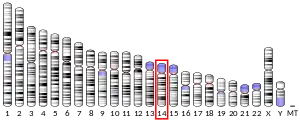Arginase, type II is an arginase protein that in humans is encoded by the ARG2 gene.[5]
Function
Arginase catalyzes the hydrolysis of arginine to ornithine and urea. At least two isoforms of mammalian arginase exists (types I and II, this enzyme) which differ in their tissue distribution, subcellular localization, immunologic crossreactivity and physiologic function. The type II isoform encoded by this gene, is located in the mitochondria and expressed in extra-hepatic tissues, especially kidney. The physiologic role of this isoform is poorly understood; it is thought to play a role in nitric oxide and polyamine metabolism. Transcript variants of the type II gene resulting from the use of alternative polyadenylation sites have been described.
References
- 1 2 3 GRCh38: Ensembl release 89: ENSG00000081181 - Ensembl, May 2017
- 1 2 3 GRCm38: Ensembl release 89: ENSMUSG00000021125 - Ensembl, May 2017
- ↑ "Human PubMed Reference:". National Center for Biotechnology Information, U.S. National Library of Medicine.
- ↑ "Mouse PubMed Reference:". National Center for Biotechnology Information, U.S. National Library of Medicine.
- ↑ "Entrez Gene: Arginase, type II".
External links
- Human ARG2 genome location and ARG2 gene details page in the UCSC Genome Browser.
Further reading
- Sankaralingam S, Xu H, Davidge ST (January 2010). "Arginase contributes to endothelial cell oxidative stress in response to plasma from women with preeclampsia". Cardiovascular Research. 85 (1): 194–203. doi:10.1093/cvr/cvp277. PMID 19684035.
- Krause BJ, Prieto CP, Muñoz-Urrutia E, San Martín S, Sobrevia L, Casanello P (May 2012). "Role of arginase-2 and eNOS in the differential vascular reactivity and hypoxia-induced endothelial response in umbilical arteries and veins". Placenta. 33 (5): 360–6. doi:10.1016/j.placenta.2012.02.006. hdl:10533/131155. PMID 22391327.
- Sousa MS, Latini FR, Monteiro HP, Cerutti JM (September 2010). "Arginase 2 and nitric oxide synthase: Pathways associated with the pathogenesis of thyroid tumors". Free Radical Biology & Medicine. 49 (6): 997–1007. doi:10.1016/j.freeradbiomed.2010.06.006. PMID 20542107.
- Gotoh T, Sonoki T, Nagasaki A, Terada K, Takiguchi M, Mori M (October 1996). "Molecular cloning of cDNA for nonhepatic mitochondrial arginase (arginase II) and comparison of its induction with nitric oxide synthase in a murine macrophage-like cell line". FEBS Letters. 395 (2–3): 119–22. doi:10.1016/0014-5793(96)01015-0. PMID 8898077. S2CID 11365908.
- Rotondo R, Mastracci L, Piazza T, Barisione G, Fabbi M, Cassanello M, Costa R, Morandi B, Astigiano S, Cesario A, Sormani MP, Ferlazzo G, Grossi F, Ratto GB, Ferrini S, Frumento G (September 2008). "Arginase 2 is expressed by human lung cancer, but it neither induces immune suppression, nor affects disease progression". International Journal of Cancer. 123 (5): 1108–16. doi:10.1002/ijc.23437. PMID 18528866.
- Warnken M, Haag S, Matthiesen S, Juergens UR, Racké K (April 2010). "Species differences in expression pattern of arginase isoenzymes and differential effects of arginase inhibition on collagen synthesis in human and rat pulmonary fibroblasts". Naunyn-Schmiedeberg's Archives of Pharmacology. 381 (4): 297–304. doi:10.1007/s00210-009-0489-6. PMID 20107769. S2CID 23774473.
- Rodrigues Pereira N, Bandeira Moss M, Assumpção CR, Cardoso CB, Mann GE, Brunini TM, Mendes-Ribeiro AC (March 2010). "Oxidative stress, l-arginine-nitric oxide and arginase pathways in platelets from adolescents with anorexia nervosa". Blood Cells, Molecules & Diseases. 44 (3): 164–8. doi:10.1016/j.bcmd.2009.12.003. PMID 20071203.
- Bron L, Jandus C, Andrejevic-Blant S, Speiser DE, Monnier P, Romero P, Rivals JP (February 2013). "Prognostic value of arginase-II expression and regulatory T-cell infiltration in head and neck squamous cell carcinoma". International Journal of Cancer. 132 (3): E85-93. doi:10.1002/ijc.27728. PMID 22815199.
- Fiori LM, Gross JA, Turecki G (September 2012). "Effects of histone modifications on increased expression of polyamine biosynthetic genes in suicide". The International Journal of Neuropsychopharmacology. 15 (8): 1161–6. doi:10.1017/S1461145711001520. PMID 22008221.
This article incorporates text from the United States National Library of Medicine, which is in the public domain.




